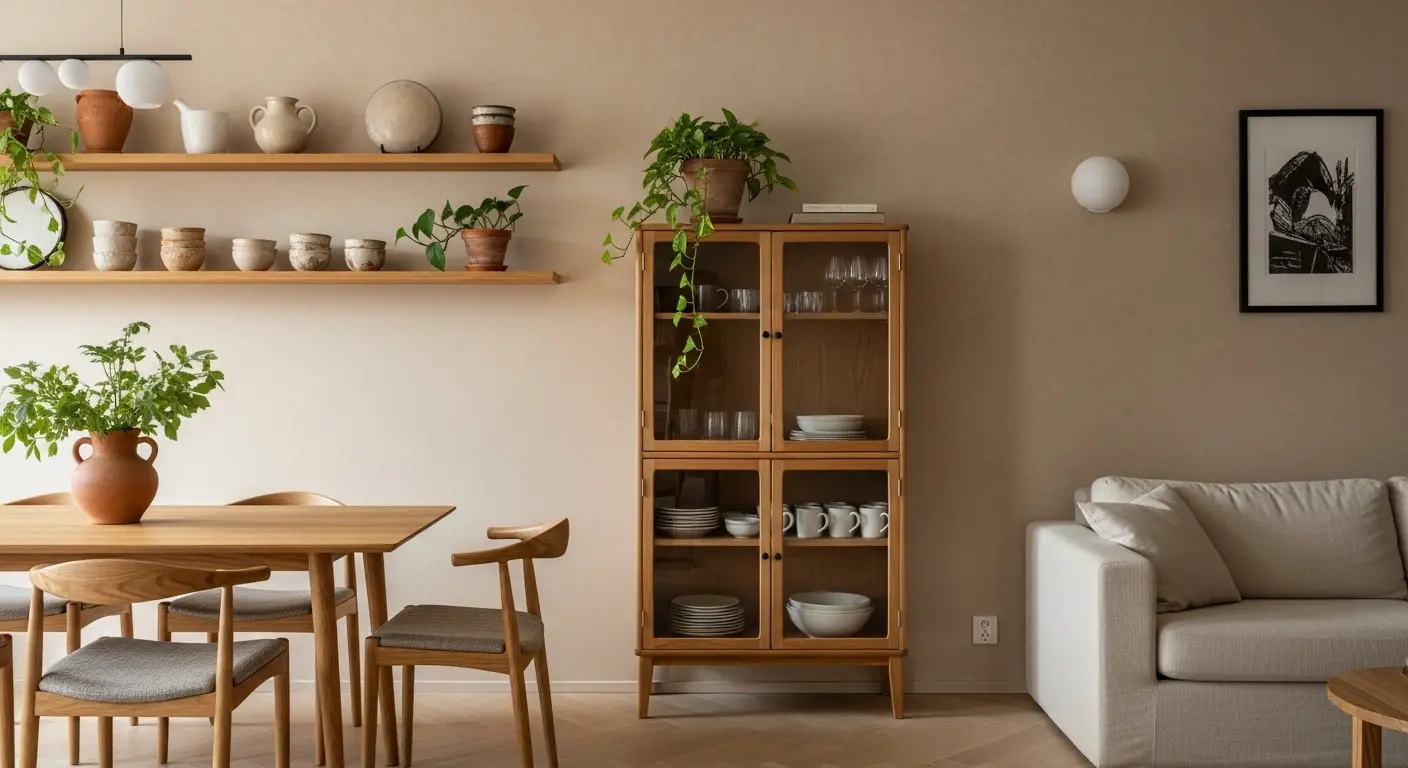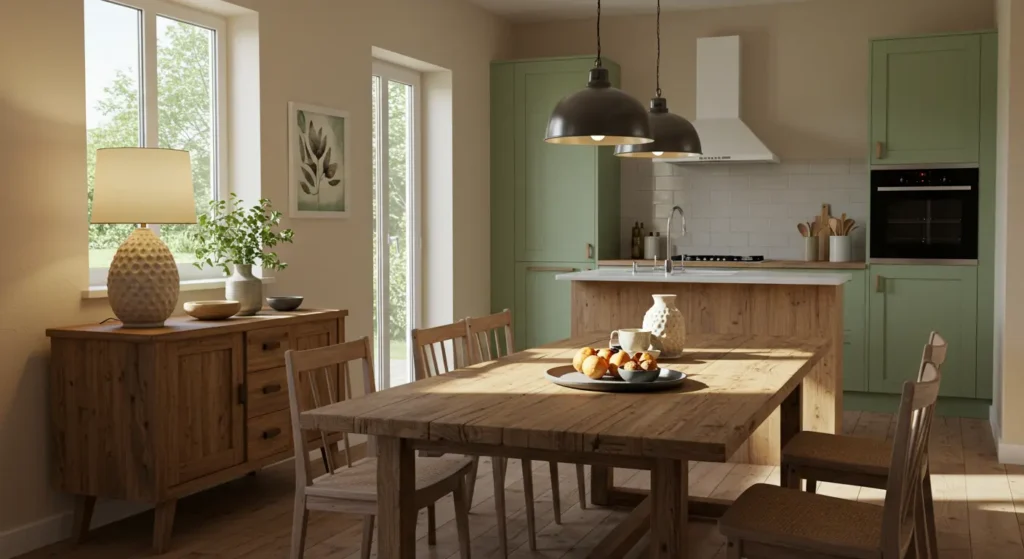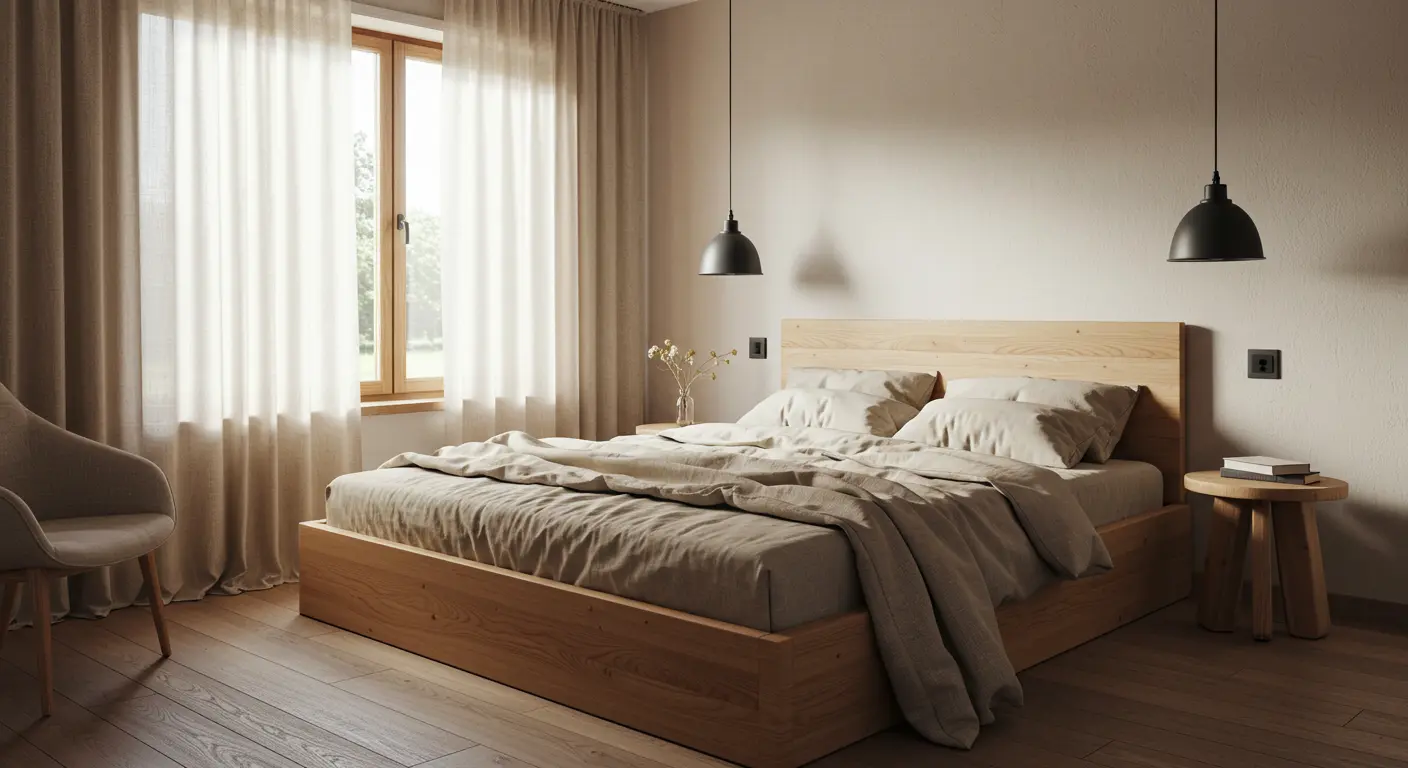
Rustic Minimalism: what if it were possible to create an environment that is light, functional, and, at the same time, full of soul? This approach unites the essential of contemporary design with the strong presence of wood, stone, and natural materials that evoke immediate coziness. More than a style, it’s an invitation to live with purpose—surrounded by welcoming textures and forms that breathe.
In this article, you will discover how to apply rustic minimalism in a balanced way, awakening the feeling of home even in the smallest spaces. Prepare to rethink your home as an authentic and inspiring refuge.
What is Rustic Minimalism?
The Fusion Between the Essential and the Natural
Rustic minimalism is more than a decoration style—it’s a visual philosophy that unites the warmth of nature with the aesthetic clarity of the essential. It arises from the intersection between minimalist design, known for its simplicity and functionality, and the rustic style, which values natural materials, imperfect finishes, and organic textures.
Unlike excessively neutral or cold environments, rustic minimalism brings visual warmth, soul, and identity, without sacrificing lightness. The central idea is to create spaces that breathe—where each element has purpose and presence.
Rustic Minimalism vs. Traditional Rustic
While traditional rustic tends to be heavier, with an excess of ornaments and robust furniture, rustic minimalism focuses on conscious reduction and careful selection of each piece. Fewer furniture pieces, more space. Fewer adornments, more raw material. It is a refined version of rustic that preserves the natural essence without overwhelming the senses.
Key differences:
- Traditional rustic can have an excess of details.
- Rustic minimalism values simple lines, functional forms, and visual balance.
- Instead of many objects, it emphasizes the quality of materials and the strong presence of wood, stone, linen, and natural fibers.
An Aesthetic with Soul, Not Excess
The great secret of this style lies in authenticity. Rustic minimalist environments are neither cold nor impersonal: they carry stories. Wood with marks of time, an exposed brick wall, a handmade bench, or a handmade ceramic piece… all these elements tell something, but without shouting.
Adopting this style is a way to seek the essential without giving up texture, nature, and human warmth. It is living with less, yes—but with much more meaning.
The Materials That Bring Rustic Minimalism to Life
Material as the Protagonist of the Environment
In rustic minimalism, materials don’t just compose the environment—they tell stories. Each texture, each fiber, each imperfection has a sensory and emotional role. Forget excessively smooth or synthetic finishes: here, beauty lies in exposed nature, the raw touch of wood, the porosity of stone, the softness of linen.
These elements are the soul of the style. They are what transform simple spaces into memorable places.
Wood: Imperfect, Alive, Essential
Among all materials, wood is the absolute star of rustic minimalism. But not just any wood. The choice falls on light wood, reclaimed wood, or wood with visible grains—the kind that proudly displays its marks.
Why use natural or reclaimed wood:
- Adds warmth and coziness to the space
- Carries a touch of history and authenticity
- Creates contrast with the simple lines of minimalist design
- Reduces the need for excessive decoration
Invest in tables, benches, shelves, and panels made of raw wood. And remember: less is more. A single well-placed piece of furniture can transform the entire environment.

Stone, Cement, and Earthy Elements
Natural stones, such as slate, sandstone, or even pebbles, bring a connection to the ground, to solid earth—literally. When combined with polished concrete floors or walls in raw tones, they create environments that breathe rustic elegance.
Use:
- Stone details on countertops, walls, or niches
- Polished concrete for floors or furniture bases
- Neutral and earthy colors that complement the raw material
Natural Fibers: Welcoming Textures
Fabrics and coverings play a fundamental role in the rustic minimalist atmosphere. Opt for linen, raw cotton, jute, sisal, or natural leather—all in neutral or earthy tones. These are materials that evoke simplicity but also embrace the body and the gaze.
Ideas to apply lightly:
- Light linen curtains
- Sisal rugs
- Pillows in rustic fabric with open weaves
- Hand-woven baskets
If you want to delve deeper into the combination of nature and simplicity in design, the article How to Create a Minimalist Environment with Natural Elements offers reflections and practical ideas for using wood, fabrics, and plants harmoniously.
The Power of the Imperfect and Handmade
In rustic minimalism, we don’t seek perfection—we seek authenticity. Handmade ceramics, a bench with marks of time, a covering that isn’t entirely uniform… all of this humanizes the environment. These are details that remind us that beauty also resides in the imperfect.
How to Apply Rustic Minimalism in Each Room
A Style That Adapts to Small Spaces with Big Soul
One of the greatest virtues of rustic minimalism is its versatility: it works just as well in country houses as in urban apartments. Even in compact spaces, it is possible to bring this style with balance, creating cozy, functional, and visually light atmospheres. Below, see how to apply it intelligently in each room of the house.
Living Room: The Warm Heart of the Home
The living room is where coziness takes shape. In this room, fewer furniture pieces and more texture is the golden rule. Opt for a linen or raw cotton sofa, a rustic wood coffee table, few decorative objects—but ones that speak about you.
Practical tips:
- Use a natural fiber rug to define the space.
- Combine neutral pillows with a thick-textured throw.
- An open shelf in light wood can hold books and affective objects.
Create a corner for visual breathing: empty space is also part of the aesthetic.
Kitchen: Simplicity with Natural Warmth
The rustic minimalist kitchen values functionality and the pleasure of preparing food in a visually calm environment. Here, wood can appear on shelves, countertops, or lower cabinets with a natural finish.
Functional inspirations:
- Cabinets without visible handles, in light wood or off-white tones
- Open shelves displaying handmade ceramics
- Countertops in stone or polished concrete to contrast with the furniture
Avoid excess decor and give prominence to natural materials.
Bedroom: Rest in its Purest Form

The rustic minimalist bedroom is an invitation to silence and comfort. Everything in it should breathe softness: from the colors to the materials of the bed and curtains.
Transformative elements:
- Bed with a solid or reclaimed wood frame
- Bedding in linen or cotton in natural tones
- Indirect lighting, with a sisal pendant or handmade wall sconce
Declutter unnecessary furniture. A bench at the foot of the bed, a plant in a clay pot, and a small rug are enough to compose without overwhelming.
Bathroom: A Natural Spa Retreat
Even the smallest bathroom can become a true rustic minimalist sanctuary. The key lies in the choice of coverings and the use of natural textures.
Ideas to transform your bathroom:
- Sink in soapstone or marble with a matte finish
- Mirror with a frame in wood or aged iron
- Natural fiber baskets for towels
- Plants that thrive in humidity, such as ferns or prayer plants
The result? A small space, but full of life, serenity, and presence.
Bonus Tip: Transition Spaces Also Count
Hallways, balconies, entrances, and forgotten corners also deserve attention. A wooden bench with a woven basket, a simple mirror, or a wall hook made of natural wood can transform these areas into small points of rustic charm, maintaining coherence throughout the home.
Colors and Lighting in Rustic Minimalism
The Palette: Neutral Base with Earthy Touches
The color palette in rustic minimalism is predominantly neutral and soft. Think off-white, beige, sand, light gray, and earthy tones like terracotta, clay, or moss green. These colors create a calm and bright base, allowing the textures of natural materials to stand out.
Avoid pure white, which can seem too cold. Prefer warmer variations that enhance the feeling of coziness.
Lighting: Soft, Indirect, and Natural
Lighting is crucial for creating the desired atmosphere. Prioritize natural light whenever possible, using light curtains that filter sunlight gently. For artificial lighting, opt for:
- Indirect light points (sconces, floor lamps)
- Lamps with shades made of natural fibers (rattan, bamboo)
- Warm yellow light bulbs (avoid cold white light)
The goal is to create a soft and welcoming ambiance, highlighting textures and promoting relaxation.
Common Mistakes in Rustic Minimalism (And How to Avoid Them)
Excess Rustic Elements
One common mistake is exaggerating the rustic elements, turning minimalism into clutter. Remember: the base is minimalist. Rustic details should appear punctually and strategically.
Solution: Choose few, high-impact rustic pieces (like a wooden table or a stone wall) and keep the rest clean and simple.
Ignoring Functionality
Rustic pieces can sometimes be bulky or impractical. In rustic minimalism, functionality is key. Every piece of furniture or object must serve a purpose beyond aesthetics.
Solution: Prioritize furniture with simple lines and practical use. Ensure good circulation and organization.
Lack of Visual Cohesion
Mixing rustic and minimalist elements without a common thread can result in a disconnected environment. Ensure that colors, materials, and textures converse harmoniously.
Solution: Maintain a consistent color palette. Repeat materials (e.g., wood) in different elements. Use lighting to unify the space.
Conclusion: Rustic Minimalism — Living with Soul and Simplicity
Rustic Minimalism is more than a style; it is a conscious choice for a lighter, more authentic, and connected life with nature. By balancing the essential with the organic, you create environments that are not only beautiful but also promote well-being and tranquility.
It is the art of finding beauty in imperfection, warmth in simplicity, and soul in raw material. A home decorated in this style becomes a true refuge—a place where you can disconnect from the outside world and reconnect with yourself.
Ready to bring this blend of nature and simplicity into your home?
